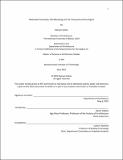Motivated Fictionality: Worldbuilding and The Thousand and One Nights
Author(s)
Soltan, Meriam
DownloadThesis PDF (12.78Mb)
Advisor
Rabbat, Nasser
Terms of use
Metadata
Show full item recordAbstract
Told and retold in countless iterations, and with roots in Persian, South Asian, and even Chinese folklore, The Thousand and One Nights has, for centuries, been amended and appended by the imaginaries of all those who have deigned to share and shape its stories. Communicated first orally, and then through a parallel textual tradition, it was only upon the arrival of the stories to Europe in the 18th century that these imaginaries would be visualized. British Orientalist Edward Lane’s richly illustrated and annotated translation (1839-41) is among the first and most prolific examples of that evolution in expression, with the 634 woodblock prints created for the edition by William Harvey positioning it as a major milestone in both the history of the Nights and popular Victorian-era illustration. Created with reference to contemporaneous architectural surveys, records, and travel writing, this was an edition that sampled from real-world observations to transform the fictions of the Nights into “a faithful and, as it were, living picture of the East.”1
This thesis foregrounds this liberal sampling of technical drawing and ethnographic research to position Lane’s Nights as both a product and producer of its time. It emphasizes this reciprocity—one that recognizes instances wherein our world has been shaped with and through the Nights in tandem— to affirm the stories not as a finite collection, but as a living fiction consistently animated by exchanges between the real and the imaginary. To do so, it looks first to 19th century trends in knowledge production and advancements in printmaking technology to trace the various scholarly and creative motivations driving Lane’s engagement with the Nights. It then offers close readings of key illustrations to demonstrate how those motivations built colonial-era travel writing, surveying, and representation into the edition. The disparate material and cultural histories embedded into those images and their associated notes are then traced to assert the joint telling and picturing of the Nights as a worldbuilding practice. A way of being in—and of—the world, worlding and worldbuilding is understood here as an active, aggregative process, wherein the work of writing and visualizing fiction is indivisible from the construction and perception of reality, of life as we experience it in real-time. Interspersed with short narrative interludes of my own designed to ground the research in an application of this very process, this thesis argues that the speculative potential promised by the Nights is enacted through a process of worldbuilding, which mediates between conceptions of the real and the imaginary.
1 “Review: The Arabian Nights Entertainments: with Copious Notes by E.W. Lane,” The Atheneum no. 572 (October
1838) 739.
Date issued
2022-05Department
Massachusetts Institute of Technology. Department of ArchitecturePublisher
Massachusetts Institute of Technology